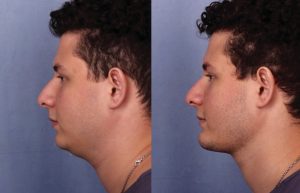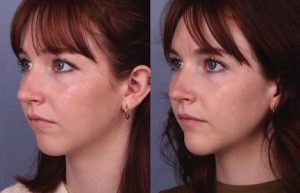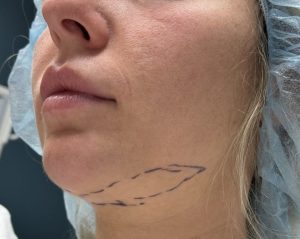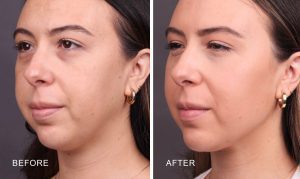The chin plays a critical role in the balance of facial features. A strong chin can create a greater appearance of strength, symmetry and self-confidence. We offer several options to enhance the size and appearance of your chin.


WHAT IS A CHIN IMPLANT?
Placement of a chin implant, also known as chin augmentation, provides definition for the lower face and balances the facial profile. Chin implants are made of various biocompatible materials and are custom-shaped for a natural looking fit. The results are permanent but can be reversed if desired.
Chin implants are used to correct a weak chin or to balance a strong nose. Patients who undergo chin augmentation love their results!
MALE CHIN AUGMENTATION
Male chin augmentation can redefine a jawline and strengthen the chin, creating facial harmony. A sharp, powerful chin is often considered the cornerstone of masculinity. Chin augmentation is a safe and effective way to restore what has been lost or enhance the current appearance.

CHIN IMPLANT & NECK LIPOSUCTION
Patients with excess fullness beneath the chin often choose to have neck liposuction at the same time as chin implant surgery. While strengthening the chin will help improve jawline definition on its own, removing excess fat from underneath the chin can further improve the appearance of the lower face and neck.

NONSURGICAL SOLUTION: INJECTABLES
Augmentation with filler is a great alternative for those who prefer nonsurgical treatment options, or who want to get a glimpse into how a chin augmentation would look.
We are pleased to announce that Dr. Madorsky’s article on the interaction between bone and chin implants has been published in Plastic and Reconstructive Surgery Global.
This research provides significant insights into the science of chin augmentation, notably by dispelling the misconception that implants cause bone erosion. The article decodes the complexities of implant-periosteum interaction and offers valuable guidance for improved chin implant procedures.
Background:
Bone resorption has been imputed to silicone chin implants as the cause of the reported bone changes with chin augmentation. Bone remodeling is complex. Both neo-ossification and bone resorption can occur.
Methods:
A literature review was performed on bone complications of silicone chin implants and bone remodeling with periosteal manipulation. Available data from plastic surgical and dental literature, alongside a case observation showing neo-ossification 10 years after implantation, were analyzed and used to explain patterns of bone changes around chin implants.
Results:
Periosteal elevation induces bone formation. Spur-like neo-ossification with silicone chin implants is caused by subperiosteal implant placement. Our case describes such neo-ossification 10 years after silicone chin implantation. The pressure of an implant on bone can cause limited bone resorption. The pressure of an implant trapped under a forming bone shelf can cause significant bone resorption in rare cases.
Conclusions:
Previously reported mandibular bone resorption ascribed to silicone chin implants has been overwrought. Bone formation is more common with silicone chin augmentation. We propose surgical modifications to limit bone complications of chin implants based on the reviewed literature. Surgical approaches to periosteal elevation and implant insertion and consideration of alternate biomaterials to silicone chin implants may improve outcomes of chin augmentation.
The jawline can be a crucial part of facial aesthetics. A strong jawline in men is often associated with attractiveness and confidence. For women, a jawline can represent youth and beauty. We offer two approaches to refining the jawline: liposuction and injectables.
LIPOSUCTION

Liposuction of the jawline is a procedure where a skilled surgeon removes excess fat to improve the jaw’s contour. It can be done on its own or combined with other facial procedures. The results of this procedure are considered permanent for most patients.

INJECTABLES
Allergan (the maker of BOTOX and JUVEDERM) has created a product specifically for the jawline. This long-lasting filler, called VOLUX, is FDA-approved and is the first and only HA filler specifically designed for jawline definition.
VOLUX is a slightly more cohesive and thicker formula than JUVEDERM VOLUMA. Both of these fillers build volume and create a lift beneath the skin, but while VOLUMA is FDA-approved for the chin and cheeks, VOLUX is FDA-approved to treat the jawline.
The procedure only takes a few minutes, and any swelling is dramatically improved within 48 hours. Results last between 12 and 18 months.

Are you looking for a “snatched” jawline? Are you tired of pushing yourself at the gym but still seeing no changes to your double chin? You are not alone! A stubborn double chin or sometimes called extra submental fat may not be your fault.
Age, genetics, and lifestyle (i.e. diet and exercise) influence the size and stubbornness of a double chin. Achieving a tight and defined jawline depends on several factors including our chin position, amount of
submental fat, and neck skin sagging.
The Youthful Neck
A youthful neckline conveys a sense of health, confidence, and attractiveness. We associate a beautiful neckline with a strong chin and jawline that creates a natural and defined transition from the jaw to the neck.
Understanding the Double Chin
Not all double chins are the same. The double chin seen in younger patients (ages 20-30s) with fullness below the chin is typically due to stubborn, excess fat just below the level of the skin (i.e. pre-platysma fat). These individuals are great candidates for less invasive treatments such as fat dissolvers (i.e. Kybella), Submental Liposuction, and occasionally Isolated Deep Neck Contouring.
Sometimes, these individuals also have a smaller, weaker chin, which makes the “double chin” even more noticeable. For these patients, I like to augment the chin with either filler or a more permanent solution such as a chin implant.
If you’re struggling with a “double chin” but none of this applies to you, don’t worry! We’re only scratching the surface of double chins on this blog. Stay tuned for our next blog where I’ll discuss more advanced treatment options.
